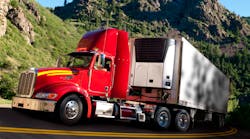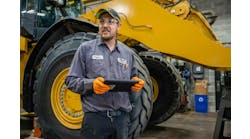Keeping transport refrigeration units (TRUs) well maintained and performing at peak operating condition is an important aspect of a reliable cold chain that safely delivers produce, meat, seafood, frozen foods, pharmaceuticals and many other products. A solid maintenance program not only helps protect refrigerated cargo, it also alleviates many unanticipated equipment failures that can lead to the expensive consequences of load losses.
Engineering and design improvements have made today’s TRUs - commonly referred to as reefers - more operationally sophisticated, fuel efficient, environmentally sound, and, from a service perspective, more durable and reliable. But these improvements, while beneficial to the overall goal of delivering refrigerated cargo safely and on time, should never take the place of a disciplined maintenance strategy.
While this maintenance overview is based on current Carrier Transicold trailer refrigeration equipment, procedures can vary among different generations of equipment and different manufacturers. As with any piece of mechanical equipment, manufacturers’ guidelines for the specific equipment should always be followed.
HYBRID REEFERS
The Carrier Transicold TRU family includes both conventional mechanical refrigeration units, as found in the X2 series, and hybrid diesel-electric units, known as the Vector family.
Hybrid units have a streamlined, all-electric refrigeration architecture that eliminates many of the routine maintenance components found in conventional belt-driven refrigeration systems. By eliminating such components, Carrier specifically designed the units for lower lifecycle costs.
Based on service history, the average amount of time required to service a hybrid unit is at least 25 percent less than a conventional belt-driven unit. Over the life of the unit, the hybrid TRU can result in a reduction of up to 30 percent in total maintenance costs, as tracked by Carrier Transicold’s Aftermarket Solutions group.
For example, the hybrid unit’s electric refrigeration system does away with all but one of the many belts and pulleys that drive a conventional system. In place of this mechanical assembly is a high-performance generator powered by the unit’s diesel engine.
Evaporator and condenser fans are driven by maintenance-free electric motors, rather than belts. Also, the electrically driven semi-hermetic compressor eliminates the compressor driveshaft and associated wear and leak concerns of a shaft seal.
The all-electric architecture of the hybrid Vector unit also eliminates maintenance items, such as the suction and discharge vibrasorbers, alternator, mechanical clutch, gearbox, mechanical fan shaft and some of the refrigeration valves.
For heating, Vector systems depart from conventional hot gas and instead use electric-resistance strips, resulting in a streamlined refrigeration circuit that uses less refrigerant.
A hybrid unit’s diesel engine still requires periodic inspections and benefits from preventive maintenance, much the same as conventional units. But over the life of the unit, there are fewer parts to deal with and reduced concerns about such issues as a mechanical failure due to something as simple as a broken or thrown belt.
SCHEDULED SERVICE
For both conventional and hybrid TRUs, recommended daily checks include oil and coolant levels, a visual check for leaks of any kind, inspection to ensure that the belts are tight, and listening for unusual noises when the unit is running.
On start-up, the microprocessor will run a self-test of the system electronics and its display will show whether any alarm conditions are detected or whether any conditions had previously been detected that require checking at the next service interval.
Before hitting the road, the unit microprocessor is also capable of running a pre-trip routine that analyzes full unit operation and tests over 15 critical functions in about eight minutes.
For conventional belt-driven TRUs, best practices recommend conducting comprehensive inspections at 750-hour intervals, and for both conventional and hybrid units, service intervals should be scheduled at 1,500-hour cycles or one year, whichever comes first.
For TRUs shipped with extended life oil filters, oil change intervals occur at 3,000 hours or two years, whichever comes first.
The recommended inspection and service cycle for conventional units is: inspection at 750 hours, inspection plus scheduled maintenance at 1,500 hours, inspection again at 2,250 hours and inspection, scheduled maintenance and oil change at 3,000 hours, and so on. Hybrid units don’t require the 750- and 2,250-hour inspections.
On average, a single-temperature refrigeration unit runs approximately 1,800 hours per year, so scheduled maintenance may occur every 10 months or so, with inspections half way between.
The control module keeps track of engine hours to help determine when it is time to do a unit service or inspection.
Engine hours are considerably less with Vector hybrid units that take advantage of electric standby power when parked. That means service intervals can stretch longer than similarly operated belt-driven units over the same time period.
INTERIM INSPECTIONS
At an interim inspection on conventional units, the following should be checked while the engine is off:
Engine oil; add as necessary.
- Air filter; reset the air filter indicator.
- Battery cables and clamps.
- Coolant level; add if needed.
- Exhaust system and mounting hardware.
- Belt condition; tighten as necessary.
The gearbox and compressor seal should also be checked for leaks. Be aware that with all open (wet) seals, such as the gearbox and compressor shaft seals, some seepage is normal.
Next, the engine should be started and checked for proper operation. The pre-trip routine should be run with all active and inactive alarms noted.
Fuel lines, oil lines, filters and the exhaust system should be observed for leaks. Technicians should listen for unusual bearing noise from components, such as belt idlers or fan shafts.
During interim inspections, water should be drained from the fuel tank and debris should be cleared from defrost drains.
SERVICE INTERVALS
When the 1,500-hour mark comes around for scheduled maintenance on hybrid and conventional units, the aforementioned inspection steps need to be performed. Note that some of the steps, such as checking the gearbox and compressor seal, only concern conventional units, because hybrid units don’t have these.
Some additional minor inspections and service are recommended at the 1,500-service interval. One is to clean the condenser and straighten the fins as necessary. Due to their location downwind of the truck’s exhaust, condenser coils can get coated with oily soot, and cleaning them helps maintain unit efficiency.
A pressure washer can be used, but care should be taken not to bend the fins. Fins that have been bent should be straightened using a fin comb.
The evaporator coil should also be inspected for restrictions and cleaned as necessary.
Other recommended additional measures:
- Inspect the water pump, air cleaner housing and tubing.
- Check the unit and engine mounting bolts for proper torque.
- Check switches and electrical connections.
With hybrid units, the insulation resistance of high-voltage wiring must be checked with a megohmmeter.
At 3,000 hours, additional scheduled maintenance includes an oil change and replacing the oil, air and fuel filters. Synthetic oil can extend oil change intervals to 4,000 hours.
At 4,500-hour service intervals, the breather should be cleaned and valve lash gap should be adjusted.
The coolant should be replaced at 6,000 hours if standard coolant is used, or at 12,000 hours if extended life coolant is used. As a preventive measure, the water pump and thermostat may be proactively changed at the 12,000-hour mark.
Although the previous measures are common to both hybrid units and conventional units, at regular intervals, conventional systems also require belt changes and extra compressor attention.
ALARM BELLS AND WHISTLES
The refrigeration unit - or at least its diesel engine - isn’t all that different from what’s under the hood of a truck, but with a truck, you always have a driver with a dashboard full of gauges to monitor its operation.
In contrast, a TRU operates behind the driver, with the only visual indicator being the status light mounted to the corner of the trailer and visible in the rear-view mirror. If the status light alerts the driver to an alarm condition, stopping for a visual check of the control display will reveal what is happening with the TRU.
The informative displays of Carrier Transicold’s Advance microprocessor and new APX control system, by way of example, provide text descriptions of problems rather than only numeric alarm codes.
A message may be something critical, such as a “Low Fuel Shutdown,” which is a forced shutdown due to an easily remedied low-fuel condition, or “Battery Not Charging,” which may require an alternator inspection. Or. it may be a more benign warning, such as “Check Coolant Temp,” a situation that warrants attention at the end of a trip.
TRU CONTROLLERS
TRU controllers themselves have become much more intelligent over the years. Each new generation of microprocessor-based controllers has provided a significant step forward in reliability, improved capacity and control and diagnostic capabilities that result in maintenance benefits.
Sophisticated controls can reduce capacity in operation, based on ambient and load conditions, thus reducing engine load and helping to prolong the life of the engine, compressor and other critical components.
Although they are no replacement for the experience, training and the well-tuned ear of a factory-trained service technician, the controllers on today’s TRUs speed up the process of diagnosing problems and can often lead a technician directly to the point of trouble.
The modular APX control system even alerts the user in the unlikely event that a module needs to be replaced via a red-glowing status LED on the module itself.
Today, many reefers are equipped with telematics - satellite or cellular communications systems that provide owners with the ability to monitor equipment location and operation.
Telematics can also provide maintenance benefits through automatic notification if a refrigeration unit in transit is experiencing a problem, enabling the dispatcher to alert the driver as to the nature of the problem and whether it needs immediate attention or not, including where to go to have the work done.
CONCLUSION
The key rationale for maintenance on a refrigeration unit is the same as the importance of maintenance on a truck - reliability. The more disciplined an owner is in adhering to a schedule of service and preventive maintenance, the better the reliability of the equipment.
Reliability helps avoid over-the-road and after-hours repairs, as well as load-loss claims, the expense of which can easily eclipse the cost of proactive maintenance initiatives.
A commitment to proper maintenance also helps ensure the longevity of the equipment and a lower cost of ownership over time - savings that can go straight to the bottom line.
In short, a solid equipment maintenance program is essential to running a cool refrigerated transport operation.



